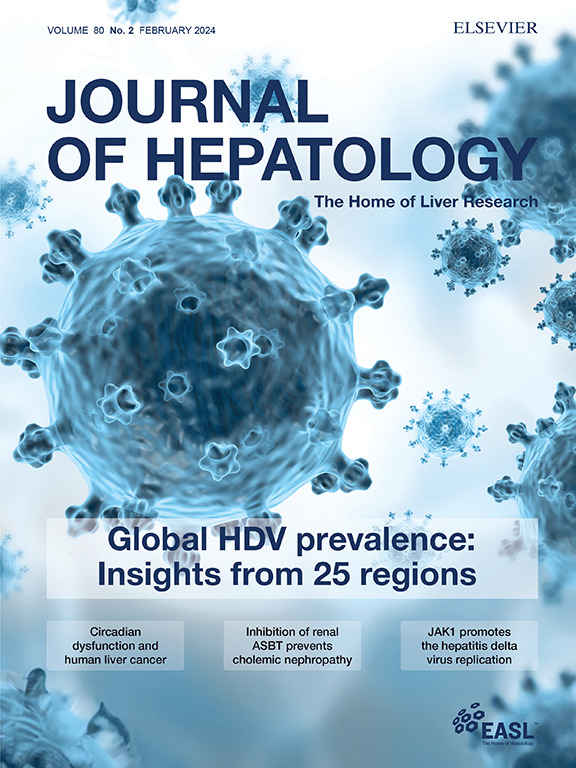挪威大鼠肝炎病毒在宿主内进化和逃避中和抗体方面类似于丙型肝炎病毒
IF 26.8
1区 医学
Q1 GASTROENTEROLOGY & HEPATOLOGY
引用次数: 0
摘要
背景和目的挪威大鼠1型肝炎病毒(NrHV)是评估丙型肝炎病毒(HCV)疫苗策略的一个有吸引力的替代模型。然而,NrHV感染中的免疫反应仍然知之甚少,特别是中和抗体(nab)的作用。在这里,我们探讨了nAb的发展和病毒进化在慢性NrHV感染近交系大鼠了解中和和病毒逃逸动力学。方法小鼠接种NrHV -rn1株后监测52周。采用RT-qPCR定量检测病毒血症,采用感染性细胞培养中和实验和攻毒实验对NrHV抗体进行鉴定。随着时间的推移,病毒进化之后是整个开放阅读框深度测序。结果大多数动物在感染20 ~ 45周后出现高水平的nab,同时包膜蛋白出现大量突变。将这些E1/E2突变纳入细胞培养适应的RHV-rn1降低了对自体当代血清中和的敏感性。5个关键的E1/E2重复置换(E209K、R224Q、V275I、T500K和L569P)被鉴定出来,它们共同损害了血清中和,其中E209K单独存在于E1中足以使中和逃逸。相比之下,无nab的nrhv感染大鼠表现出较少的包膜突变。最后,用高滴度nab的大鼠血清预处理细胞可以部分控制nrhv感染,并且用这种血清被动免疫可以保护SCID小鼠免受后续的攻击。结论NrHV长期感染过程中nab与病毒进化存在相关性。观察到的NrHV感染的体液免疫与慢性HCV感染非常相似,在慢性HCV感染中,晚出现的高水平nab无法清除不断进化的病毒群,从而有助于逃避适应性免疫反应。然而,预先存在的抗体确实可以防止感染。本文章由计算机程序翻译,如有差异,请以英文原文为准。

Norway rat hepacivirus resembles hepatitis C virus in terms of intra-host evolution and escape from neutralizing antibodies
Background and Aims
Norway rat hepacivirus 1 (NrHV) is an attractive surrogate model for evaluating vaccine strategies against hepatitis C virus (HCV). Yet the immune response in NrHV infections remains poorly understood, particularly the role of neutralizing antibodies (nAbs). Here, we explore nAb development and viral evolution during chronic NrHV infection of inbred rats to understand neutralization and viral escape dynamics.Methods
Lewis rats inoculated with the NrHV RHV-rn1 strain were monitored for >52 weeks. Viremia was quantified by RT-qPCR, and NrHV nAbs were characterized by infectious cell culture-based neutralization assays and challenge experiments. Viral evolution was followed over time by whole open reading frame deep sequencing.Results
In most animals, high levels of nAbs appeared after 20 to 45 weeks of infection, coinciding with the emergence of numerous mutations in the envelope proteins. Incorporation of these E1/E2 mutations into cell-culture-adapted RHV-rn1 reduced sensitivity to neutralization by autologous contemporary serum. Five key recurrent E1/E2 substitutions (E209K, R224Q, V275I, T500K, and L569P) were identified, collectively impairing serum neutralization, with E209K in E1 alone proving sufficient to confer neutralization escape. In contrast, NrHV-infected rats devoid of nAbs displayed fewer envelope mutations. Finally, pretreatment of cells with rat serum with high-titer nAbs led to partial control of NrHV-infection, and passive immunization with such sera protected SCID mice from subsequent challenge.Conclusions
This study demonstrates the correlation between nAbs and viral evolution during long-term NrHV infection. The observed humoral immunity for NrHV infection closely resembles that of chronic HCV infection, where late-emerging high-level nAbs fail to clear evolving viral populations, thereby contributing to the evasion of the adaptive immune response. Preexisting antibodies do, however, protect from infection.求助全文
通过发布文献求助,成功后即可免费获取论文全文。
去求助
来源期刊

Journal of Hepatology
医学-胃肠肝病学
CiteScore
46.10
自引率
4.30%
发文量
2325
审稿时长
30 days
期刊介绍:
The Journal of Hepatology is the official publication of the European Association for the Study of the Liver (EASL). It is dedicated to presenting clinical and basic research in the field of hepatology through original papers, reviews, case reports, and letters to the Editor. The Journal is published in English and may consider supplements that pass an editorial review.
 求助内容:
求助内容: 应助结果提醒方式:
应助结果提醒方式:


